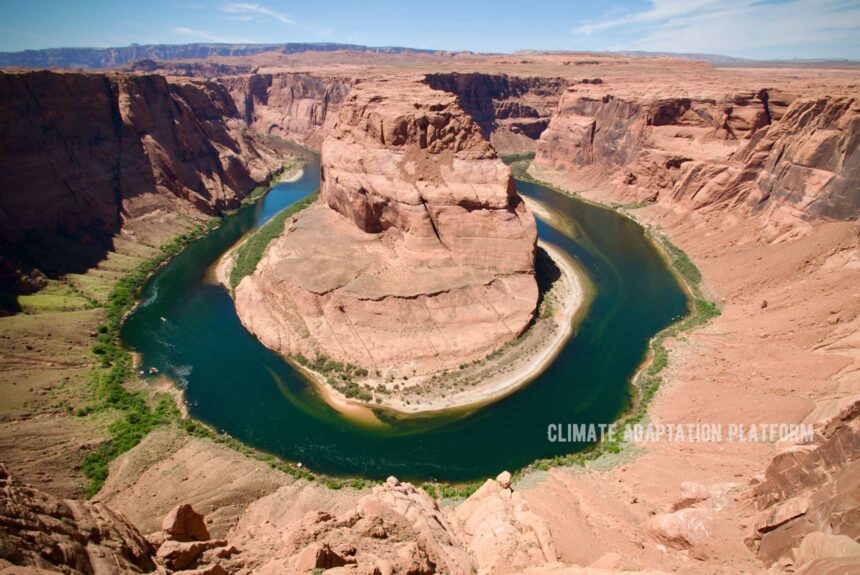Colorado River faces historic low water levels caused by decades of droughts, demands, overuse, and climate change.
Forty million people in seven western states: Arizona, Nevada, New Mexico, Colorado, Utah, Wyoming, and California rely on the vanishing river for water and electricity, and also its agriculture industry worth $5 billion annually.
Colorado River supplies the Dams at Lake Mead and Lake Powell that generate power for four million people. Still, climate change has worsened the drought, with the western US experiencing its driest condition in at least 1,200 years.
As a result, the country’s two largest water levels have reached record lows and are approaching “dead pool” levels, at which water stops flowing downstream.
In 2021 the federal government declared the river’s first-ever water shortage. CNBC reports that in August 2022, for the second time in a row, the federal government imposed mandatory cuts for the state of Arizona, Nevada, and Mexico for their water consumption starting January of the following year (Clifford, 2022).
Arizona will have to reduce 592,000 acre-feet of its water usage, representing 21% of the state’s use, Nevada by 25,000 acre-feet or 8% of its consumption, and Mexico by 7% of its annual appointment, the article says.
The article notes that the 23-year drought has been drying up the Colorado River, and the effects of climate change, both in terms of extreme heat and low precipitation, are making that more severe.
“The worsening drought crisis impacting the Colorado River Basin is driven by the effects of climate change, including extreme heat and low precipitation,” said deputy secretary of the Department of the Interior Tommy Beaudreau, in a statement announcing the required cuts.
Arizona representatives are unhappy about the disproportionate amount of cuts required for the benefit of other states as they feel that all the basin states should also reduce their share of water consumption.
CNN reports that the US Bureau of Reclamation requires the seven states to propose ways to conserve 2m to 4m acre-feet of water or as much as 30% of their river water allocation. If each state cannot agree on how to do it, the Federal government will decide how the states manage their water use (Nilsen, 2023).
Federal officials also estimate that around 10% of water is being lost to evaporation and leaky infrastructure and that states should account for these water losses and share them among themselves.
On 30 January 2023, the six states except for California released a letter and a proposed model to drastically reduce their water use from the Colorado River to prevent its collapse and avert Lake Mead and Lake Powel from hitting a “dead pool”.
These six states propose a maximum cut of 3.1-million-acre feet annually, which includes water conservation and evaporation.
California, the largest consumer of the Colorado River, plans for a more modest cut of around 1-million-acre feet instead.
According to the article, it is hard for California and Arizona to agree on water cuts because of the legality of who is first in line for water cuts.
California has so far been spared from cuts because it has some of the oldest and most secure water rights, particularly the Imperial Irrigation District or IID, the largest irrigation district in the nation.
The IID holds a senior right to the water, which entitles it to use 3.1 million acre-feet of Colorado River annually, where 97% is used for agricultural purposes to “grow the food and fibre to feed the nation and the world.” The remaining 3% it delivers to the seven municipalities for industrial, household, and business use (Water, 2023).
On the other hand, Arizona agreed to a junior water right in 1968 in exchange for building the Central Arizona Project, a system of canals that distribute the Colorado River’s water to cities and farms from Phoenix to Tucson, which makes the state the first in line for cuts.
The CNN article says that Arizona recently argued that future cuts should be shared equally rather than them getting to zero allocation.
But the problem is bigger than the states’ legal entitlement to the water or how much they are willing to give out.
If California challenges the other six states’ plans and the Federal government’s water cuts mandates, the battle could easily land on the nation’s highest courts. But then future litigation will further delay required actions on the river.
David Hayes, a former top climate aid to President Joe Biden and now at Stanford University Law School, says, “The issue is bigger than any group of water rights holders” (Nilsen, 2023).
“A hundred-year-old agreement is not necessarily going to be around for another 100 years, and the whole system could get blown up”, Hayes says regarding the senior rights to the water that California staunchly defends (Nilsen, 2023).
Sources:
Newburger, E. (2023, January 1). Colorado River deadline passes with no deal on voluntary water cuts. CNBC. Retrieved from https://www.cnbc.com/2023/01/31/colorado-river-shortage-states-miss-deadline-for-deal-on-water-cuts.html
Clifford, C. (2022, August 17). Feds call for water cutbacks ‘to avoid a catastrophic collapse’ of Colorado River. CNBC. Retrieved from https://www.cnbc.com/2022/08/17/feds-call-for-water-cutbacks-as-colorado-river-is-in-23-year-drought.html
Nilsen, E. (2023, January 30). A showdown over Colorado River water is setting the stage for a high-stakes legal battle. CNN. Retrieved from https://edition.cnn.com/2023/01/30/us/colorado-river-water-california-arizona-climate/index.html
The most important river in the American West is drying up. (2022, 16 August). The Economist. Retrieved from https://www.economist.com/graphic-detail/2022/08/16/the-most-important-river-in-the-american-west-is-drying-up
Bland, A. (2023, 1 February). California, other states reach impasse over Colorado River. Palo Alto. Retrieved from https://www.paloaltoonline.com/news/2023/02/01/california-other-states-reach-impasse-over-colorado-river
Water. (2023). IID. Retrieved from https://www.iid.com/water



Leave a Reply